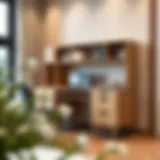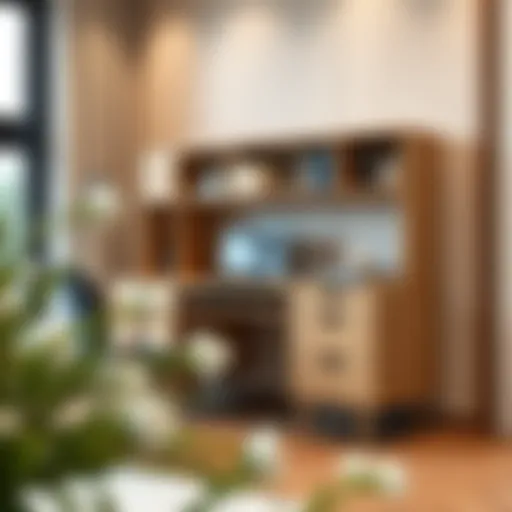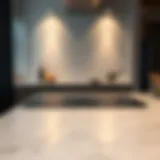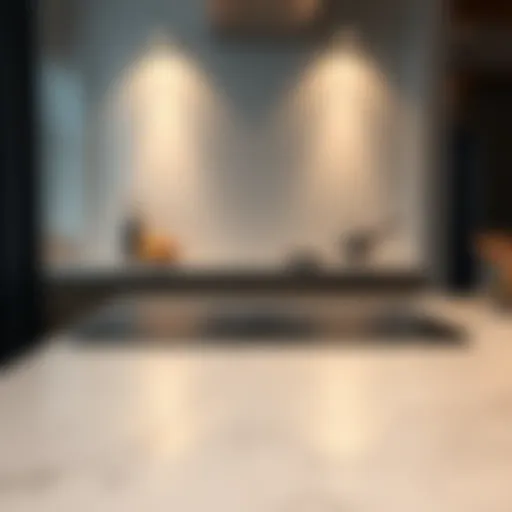Understanding Kitchen Sink Faucet Hose Extensions

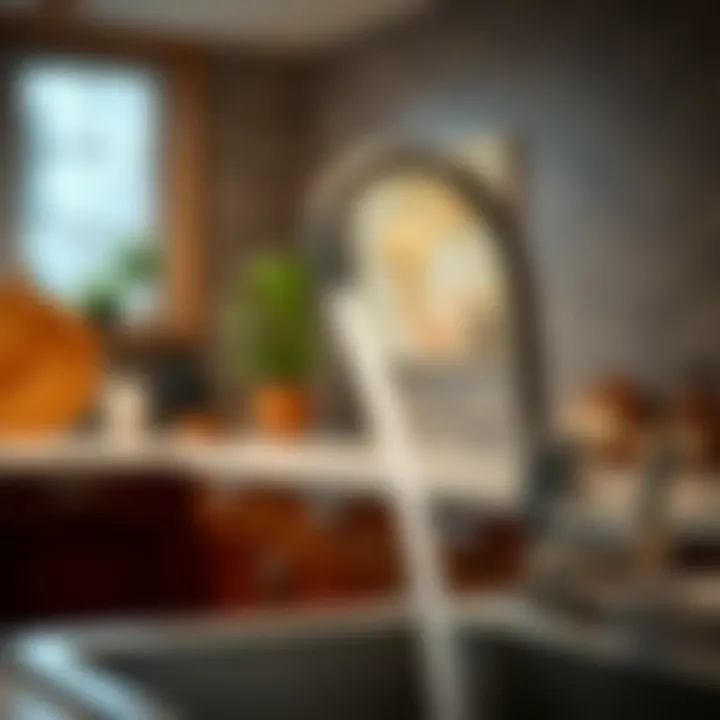
Intro
Kitchen sink faucet hose extensions often go unnoticed amid the myriad of fixtures and gadgets filling modern kitchens. However, these handy little devices can significantly enhance your day-to-day cooking and cleaning routines. They stretch your reach, allowing you to easily maneuver and control water flow where it's most needed, ultimately improving your kitchen experience.
Understanding the various aspects of faucet hose extensions is crucial for homeowners and DIY enthusiasts hoping to optimize their kitchen environments. From installation to maintenance, knowing how to leverage the capabilities of these extensions can lead to smarter kitchen setups. We'll explore their functionality, the different types available, compatibility considerations, and some practical tips for maintaining these tools.
Prolusion to Kitchen Sink Faucet Hose Extensions
When it comes to kitchen functionality, the faucet often takes center stage. A well-designed faucet, coupled with a hose extension, can completely transform the way we interact with our sinks. This section highlights how kitchen sink faucet hose extensions can contribute to both convenience and efficiency in our daily routines, allowing for greater versatility in cooking and cleaning tasks.
Definition and Purpose
A kitchen sink faucet hose extension is a flexible tube that connects to a standard kitchen faucet, allowing the user to extend the reach of water flow beyond the immediate sink area. These extensions are designed to facilitate a variety of tasks, from rinsing vegetables and filling pots to washing dishes and cleaning the sink itself. The primary purpose is to enhance reach and maneuverability, helping homeowners manage everyday chores with ease. Not only do they simplify tasks, but they also contribute to water conservation by allowing precise targeting of water flow, minimizing waste.
Historical Context
The origins of kitchen sink faucet hose extensions trace back several decades. Early incarnations started as rudimentary attachments, often lacking the refinements we see today. The evolution of plumbing technology brought about significant improvements—materials became more durable and flexible, with advancements in design catering to user comfort and convenience. Early designs might have used materials like metal, prone to rusting and wear, while modern hoses utilize high-quality rubber or polymer materials that are both resistant to chemical damage and wear. This progression not only mirrors changes in household design aesthetics but also aligns with shifts toward more sustainable practices within the home, as water-efficiency standards become increasingly important among consumers.
"Hose extensions are not merely accessories; they can be integral to achieving a streamlined workflow in the kitchen."
The integration of hose extensions into kitchens has mirrored societal changes as well. Homeowners now prioritize convenience and sustainability, which is evident in their preferences for products that enhance both performance and environmental responsibility. With today’s technology, these extensions are designed to fit various faucet types, ensuring compatibility and usability across numerous household scenarios.
Types of Kitchen Sink Faucet Hose Extensions
In the realm of kitchen plumbing, understanding the types of kitchen sink faucet hose extensions is paramount. Each type caters to varying needs and designs, making them essential for optimizing functionality and usability in your kitchen. Choosing the right kind can enhance your sink's capabilities and make daily tasks much easier. Let's break this topic down further into the specific types available.
Standard Hose Extensions
Standard hose extensions are your go-to option for basic kitchen needs. Typically, these extensions maintain a consistent diameter throughout which allows for a steady flow of water. They are largely compatible with most conventional faucets found in many households.
Benefits of Standard Hose Extensions:
- Affordability: These are often the most cost-effective choice, catering to those keeping an eye on budgets.
- Ease of Use: Installation usually requires minimal time and effort, making them appealing for DIY enthusiasts.
- Versatility: They can fit a variety of sinks and faucets, making them a hassle-free addition to your kitchen setup.
However, it’s essential to note that while these hoses provide excellent performance in most situations, they lack the maneuverability often desired for more complex kitchen tasks.
Pull-Out and Pull-Down Extensions
Pull-out and pull-down hoses offer a dynamic solution for kitchen faucets. The main difference is how they operate. Pull-out hoses extend away from the base and can be easily retracted, while pull-down configurations allow the nozzle to be pulled down directly into the sink area. This design encourages flexibility and greater reach, which is particularly useful for washing larger pots or cleaning the sink itself.
Considerations for Pull-Out and Pull-Down Extensions:
- Space Efficiency: Their sleek design often provides better access, making it easier to fill tall containers without the usual hassle.
- Modern Aesthetic: These extensions frequently come in stylish designs and finishes, which can enhance the overall look of your kitchen.
- User-Friendly: They often include features like spray settings, which help in intensive cleaning tasks.
Yet, it's important to ensure compatibility with the existing faucet design before making a purchase, as not all sinks are suited for these advanced systems.
Flexible and Rigid Options
When talking about hose extensions, the choice between flexible and rigid options presents distinct advantages. Flexible hoses are made from materials designed to bend and shape according to your needs. This adaptability can be incredibly useful in tight spaces or complex sink designs. On the other hand, rigid hoses provide reliable strength and stability, making them ideal for heavy-duty tasks.
Why Choose Flexible or Rigid Options?
- Flexibility: The maneuverability of flexible options allows for adjustments as needed, making everyday tasks simpler.
- Durability: Rigid hoses often come with reinforced interiors, providing a longer lifespan, especially in high-usage environments.
- Installation Choices: With varying designs available, homeowners can select the option that best fits their kitchen's layout and aesthetic preferences.
In summary, the variety in hose extensions empowers homeowners and designers alike to tailor solutions to their unique sets of circumstances and needs. Each type offers specific advantages that can enhance the functionality and aesthetics of any kitchen.
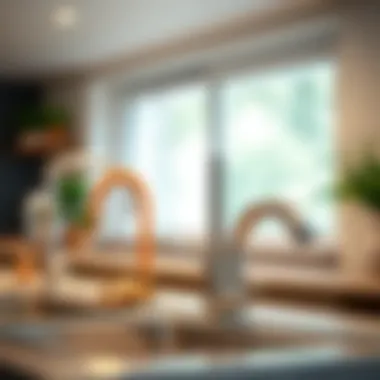
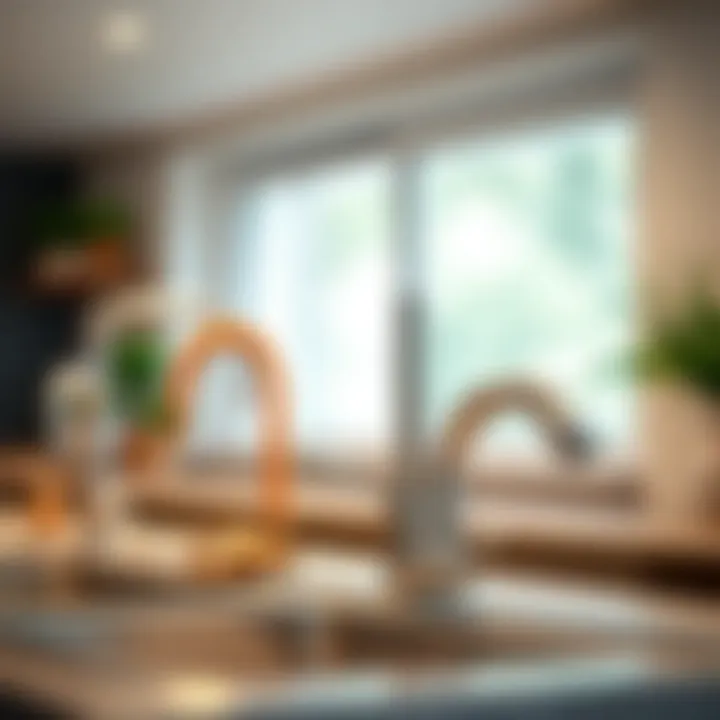
Benefits of Using Hose Extensions
Understanding the benefits of utilizing hose extensions for your kitchen sink faucet can significantly enhance your daily kitchen tasks. It’s not just about having a fancy gadget; these extensions offer practical solutions to common challenges. They render a variety of useful functions, making them an important item to consider for both new and existing kitchen setups.
Enhanced Reach and Flexibility
Utilizing hose extensions can greatly improve your reach in the kitchen. For instance, consider a scenario where you’re filling a large pot in a corner of your counter. A standard faucet may require awkward repositioning, but with an extended hose, you can easily maneuver and reach into tough spots without straining yourself.
The flexibility that these hoses provide allows you to clean or rinse beyond typical boundaries. You can even use it to water indoor plants or clean fruits and vegetables, a handy feature that many under-appreciate.
This versatility is not just convenient; it can also alleviate potential back pain or strain from reaching too far into your sink.
Improved Cleaning Efficiency
A significant advantage of hose extensions lies in the cleaning efficiency they offer. Extended hoses often come with various spray settings. For example, you might find a strong jet spray useful for rinsing stubborn food remnants off dishes or pots. This eliminates the need for pre-soaking and scrubbing, allowing you to get your kitchen tasks done in less time.
Moreover, the ability to direct water exactly where it’s needed makes for a more thorough clean.
Imagine having to wash down your kitchen countertop without needing to awkwardly tilt and angle your faucet—this is what extensions provide. In terms of eco-friendliness, improved cleaning means less soap and water usage, which benefits both your budget and the environment.
Water Conservation Features
Water conservation is becoming a buzzword in today’s green-conscious world, and hose extensions contribute significantly to this cause. Many modern hose extensions incorporate sustainable design features that help reduce water usage. Factors include adjustable flow rates and mechanisms that can temporarily shut off the water supply when not needed, such as when you’re scrubbing a dish or rinsing produce. According to various studies, households can save thousands of gallons of water each year simply by incorporating more efficient fixtures. Therefore, not only do hose extensions aid in functionality, but they also align with broader environmental goals.
Compatibility with Existing Fixtures
Compatibility is a crucial factor to consider when installing kitchen sink faucet hose extensions. Understanding how these extensions mesh with your existing fixtures can save you time, money, and a lot of headaches down the line. Homeowners, DIYers, and designers alike need to be aware of the compatibility issues that could arise because not all faucets are created equal. It’s just as important as choosing the right style or finish for your kitchen.
Assessing Faucet Types
The first step in determining compatibility is identifying your faucet type. Most traditional sink faucets fall into a few major categories: single-handle, dual-handle, pull-out, and pull-down faucets.
- Single-Handle Faucets: These typically have a lever that controls both the temperature and the water flow, making installation straightforward but requiring that the hose extension fits correctly to avoid leakage.
- Dual-Handle Faucets: These require a bit more attention. If you want to add a hose extension, check that it won't interfere with the hot and cold water controls.
- Pull-Out and Pull-Down Faucets: These are designed for flexibility and reach and usually come with a built-in hose. However, it's essential to make sure any new extension can be easily integrated without affecting its functionality.
Taking a closer look deeper into faucet styles can also make a world of difference. For instance, if you own a wall-mounted faucet, the hose extension will likely need distinct installation adjustments compared to a standard deck-mounted faucet. Identifying these distinctions at the outset can help keep avoidable complications at bay.
Connection Types and Requirements
Once you have assessed the faucet type, the next step is to understand the connection types and their requirements. This includes knowing the thread size, type, and whether you require a specific adapter. The most common connection sizes for faucet hoses are ½ inch and ⅜ inch, though some especially older models might differ.
"Not being aware of connection requirements might lead to unplanned trips to the hardware store for parts you didn't know you needed."
To simplify your installation, here’s a checklist to assess your current setup:
- Evaluate the Hose Size: Measure the existing hose connection to determine the size.
- Check Thread Type: Is it male or female threading? Knowing this ensures you choose a compatible extension.
- Look for Adapters if Necessary: Sometimes adapters are required for fittings that don’t match. Adapters come in various shapes and sizes; be sure to choose one that meets plumbing codes in your area.
As a rule of thumb, always opt for quality components to enhance your extension's lifespan and performance. Poorly made parts can lead to leaks and other issues, defeating the purpose of your hose extension. In the long run, it’s the little details that lead to plumbing happiness.
By taking the time to assess both the faucet types and connection requirements, you're setting yourself up for a smoother experience with your hose extension installation, greatly enhancing the overall functionality of your kitchen.
Installation Process
Installing a kitchen sink faucet hose extension is a crucial step that can significantly enhance your kitchen's functionality. This process may initially seem daunting, especially for those unfamiliar with plumbing. However, understanding the installation process is essential, as it ensures that your hose extension not only works properly but also lasts over time. With the right approach, you can maximize the utility of your sink and ease your daily kitchen tasks.
Necessary Tools and Materials
Before diving into the installation process, it's vital to gather all necessary tools and materials. This preparation will save you time and frustration. Some key items include:
- Adjustable Wrench: For tightening connections without damaging the fittings.
- Screwdriver: Both flathead and Phillips types may be necessary for securing components.
- Teflon Tape: This helps create a watertight seal on threaded connections.
- Hose Extensions: Make sure to select the right size and type based on your existing fittings.
- Bucket: Useful for catching any water drips during installation.
Additional materials might include:
- Pipe Joint Compound: For added sealing if needed.
- Pliers: Helpful for grip and maneuvering nuts and bolts.
Step-by-Step Installation Guide
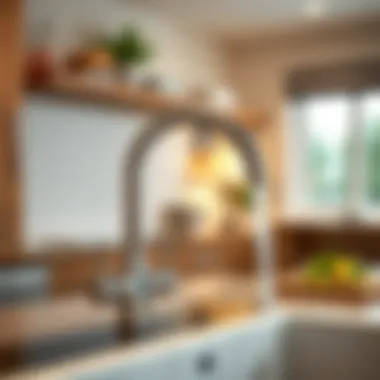
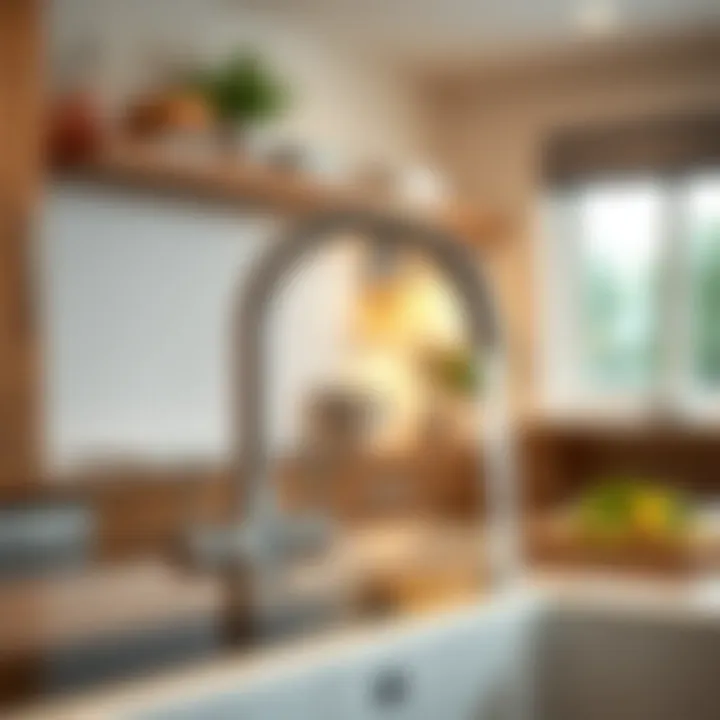
Now that you have your tools ready, here’s a straightforward guide to assist you in installing the hose extension:
- Turn Off the Water Supply: Locate the shutoff valves under the sink and turn them off to avoid any unexpected water flow.
- Remove the Old Hose: Disconnect the current hose from the faucet. Use the adjustable wrench to loosen any fittings and unscrew them.
- Prepare the New Hose: Before installing the new extension, wrap Teflon tape around the threads of your faucet connection to ensure a tight seal.
- Attach the Hose Extension: Screw the new hose onto the faucet, ensuring that it is tight but not over-tightened. Check that the hose is aligned properly to avoid kinks or bends.
- Connect to Water Supply: If your hose has a connection to the water line, connect that as well. Use the adjustable wrench to ensure it is secure.
- Turn On the Water Supply: Slowly turn the water back on, checking for leaks around the connections.
- Test the Hose: Run the faucet to ensure water flows freely through the new extension.
By following these steps thoroughly, you can ensure a solid installation that enhances your sink's capability.
Common Mistakes to Avoid
Mistakes during installation can lead to frustrating leaks or other complications. Here are some common pitfalls to watch out for:
- Neglecting to Turn Off the Water Supply: Forgetting this step can lead to a mess and potential water damage.
- Improper Sealing: Failing to use Teflon tape or not applying it correctly can result in leaks.
- Over-Tightening: While it’s essential to secure connections, over-tightening can damage fittings and create leaks.
- Not Testing Properly: After installation, it’s crucial to test the setup. Minor leaks might only show up after some water flow, so take a moment to run the faucet and check.
- Ignoring Manufacturer Instructions: Different hose extensions might come with specific installation guidelines. Always refer to these for the best results.
Proper installation is not just about getting the job done; it's about ensuring longevity and efficiency. Don't rush through the process to avoid future headaches.
Maintenance Tips for Hose Extensions
Taking care of your kitchen sink faucet hose extensions is crucial for ensuring longevity and optimal performance. Just like any other fixture in your home, these hoses benefit from regular attention, which can prevent potential issues down the line. Proper maintenance not only extends the lifespan of the hoses but also enhances the overall kitchen experience by ensuring efficient water flow and reducing the risk of leaks or water damage.
Cleaning and Care
Keeping your hose extensions clean is not just about aesthetics; it plays a significant role in maintaining functionality. Here are some practical tips to follow:
- Regular Inspection: Make it a habit to check the hoses at least once a month. Look for any signs of wear, cracks, or loose connections.
- Wipe Down: A simple wipe down with a damp cloth can remove buildup from soap scum, grease, or mineral deposits. For areas with stubborn grime, consider using a mixture of vinegar and water. It's effective and non-toxic.
- Avoid Harsh Chemicals: While it may be tempting to use powerful cleaners, they can deteriorate the materials of your hoses over time. Stick to gentler cleaning solutions.
- Flush the System: Occasionally, running hot water through the hose without attachments can help clear out any sediment. If your area has hard water, this might be especially beneficial.
Troubleshooting Common Issues
Even with the best intentions, issues may arise with hose extensions. Here are some common problems and their solutions:
- Low Water Pressure: If you find that water pressure is weaker than usual, check for kinks or bends in the hose. An obstructed path can dramatically reduce water flow. Straightening the hose may remedy the issue. If the hose has become clogged, consider flushing it with water, as discussed earlier.
- Leaking Connections: Leaks often stem from loose fittings or worn washers. If you detect water pooling around the base of the faucet, it may be time to tighten the connection or replace the washer. A well-fitted hose is your best defense against annoying leaks.
- Unpleasant Odors: An unpleasant smell can signal stagnant water or accumulated bacteria within the hose. Cleaning the hose thoroughly and allowing it to air dry can help eliminate bad smells and improve water quality.
"A little maintenance can save a lot of trouble. Regular checks and care will keep your faucet hoses in good working condition for years to come."
Innovative Design Options
The realm of kitchen sink faucet hose extensions has evolved remarkably, with innovative design options emerging to meet the needs of both aesthetic appeal and functional superiority. As homeowners and DIY enthusiasts look to enhance their kitchen spaces, it is vital to consider these modern design features that blend form and function. This section will delve into the significance of innovative design options, highlighting aesthetic considerations and the right materials for durability.
Aesthetic Considerations
When it comes to choosing a hose extension, the first thing that often catches the eye is the design. There’s a certain charm in a well-designed kitchen, and the faucet can play a starring role in that image. An extension can range from sleek and modern, available in finishes like polished chrome or matte black, to more vintage styles that hark back to simpler times, with brass or bronze finishes.
Consider the existing decor of your kitchen. Does your space adopt a minimalist vibe with clean lines and uncluttered surfaces? If so, opting for a low-profile hose extension can enhance the overall aesthetic without overwhelming the space. Alternatively, if your kitchen has a rustic or farmhouse feel, a more ornate design might be just the ticket. When choosing, keep in mind:
- Color Coordination: Select a finish that matches your other fixtures for a harmonious look.
- Shape and Form: Ensure the design integrates well into the overall style of your kitchen.
- Visibility: Some extensions retract or tuck away to keep a cleaner look when not in use.
These considerations not only elevate the visual appeal but also can add a sense of personal flair—a stylish hose extension can become a focal point rather than a mere utility.
Material Selection for Durability
In any kitchen, durability is non-negotiable. The materials chosen for hose extensions can significantly impact their lifespan and performance. Look for options made of high-quality materials that resist corrosion, wear, and tear. Here’s what to consider:
- Stainless Steel: Known for its strength and resistance to rust and discoloration. It's a popular choice for those looking for both longevity and style.
- Silicone: Typically used for parts that require flexibility. It resists cracking and is often used in conjunction with other materials to enhance specific features.
- Brass: A classic material that offers robust durability while providing a distinct aesthetic appeal. However, brass can tarnish, so regular upkeep is recommended.
Beyond just the materials, the manufacturing process also plays a role. A product made with precision engineering can promise fewer leaks and optimized performance. Always consider how well a hose will hold up to daily rigors.
Remember: Durability is not merely about the material itself. It's about how well it’s put together and whether it can withstand the test of time in the busy environment of a kitchen.
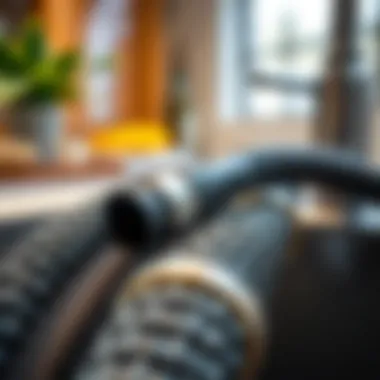
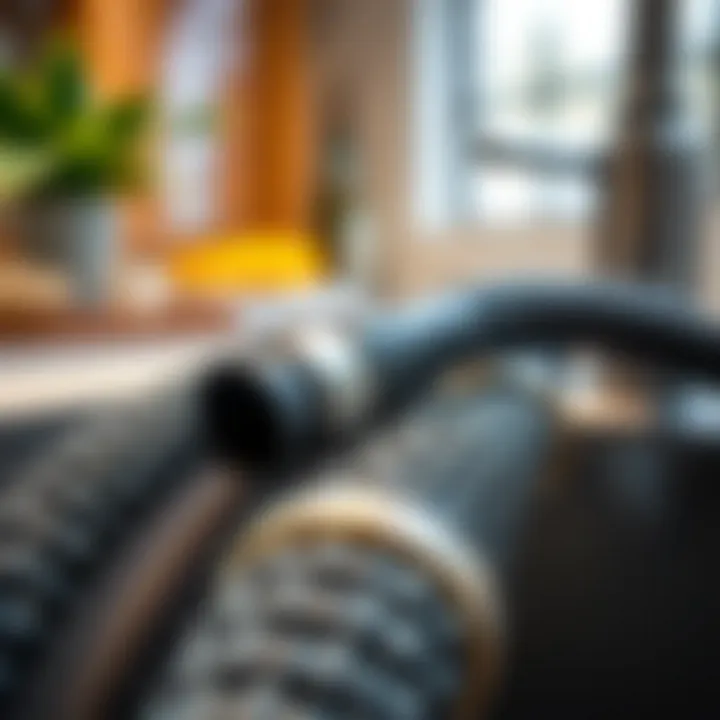
By thoughtfully considering both aesthetic elements and material durability, you can choose hose extensions that not only enhance the visual appeal of your kitchen but also provide a reliable and long-lasting solution for your plumbing needs. Balancing design with practicality should lead you down the path to making an informed choice.
Environmental Impact of Hose Extensions
The environmental ramifications of using kitchen sink faucet hose extensions extend beyond mere convenience and functionality. In today's world, where sustainability is a pressing concern, understanding how these extensions affect our environment is essential. Choosing the right materials and designs can significantly decrease waste and enhance our water usage. This section dives into the pivotal aspects that homeowners, designers, and DIY enthusiasts should consider regarding the environmental implications of faucet hose extensions.
Sustainability in Material Choices
When it comes to kitchen plumbing, not all materials are created equal. The market is filled with hose extensions made from different substances, each bringing its own level of environmental impact. Selecting sustainable materials not only benefits the environment but can also enhance the longevity of the extension itself.
- Recyclable Materials: Look for hose extensions made from materials that can be recycled after their lifespan. For instance, some brands use high-grade plastics like PVC, which can reduce landfill waste when disposed of properly.
- Eco-Friendly Certifications: Certain products carry certifications indicating they meet strict environmental standards. When shopping, check for labels like Energy Star or Environmental Product Declaration (EPD).
- Durability Over Time: Choosing durable materials might seem a bit pricier upfront, but they can save you costs in the long run by reducing the need for replacements. Stainless steel, for instance, tends to endure wear better than plastic options.
Energy and Water Efficiency
Hose extensions can be a game-changer when it comes to optimizing water and energy usage in your kitchen. This efficiency becomes increasingly important considering that water scarcity and energy conservation are global challenges. The right hose extension can significantly lower both your water bills and environmental footprint.
- Smart Features: Modern extensions often come equipped with features like flow reducers or aerators, which maintain water pressure while using less water. This not only helps in conserving precious water but can also lower your utility bills.
- Reduced Hot Water Usage: If your hose extension reaches further than your standard faucet, you may find you need less hot water to complete tasks, especially in cleaning or rinsing large items. This minimizes energy use associated with heating water.
- Integrating with Rainwater Systems: Some hose extensions can even be adapted to work with rainwater collection systems, promoting further sustainability. Using harvested rainwater for washing kitchen items is a beneficial practice both for your home and the environment.
By bringing together smart choices in materials and features, homeowners can not only enhance their kitchen experience but also contribute to a more sustainable future.
In essence, understanding the environmental impact of kitchen sink faucet hose extensions involves looking closely at both the materials used and the efficiency of the designs. By prioritizing sustainability and efficiency, we can ensure our culinary spaces are not only functional but also environmentally friendly.
Market Overview
In today's DIY-centric world, the market for kitchen sink faucet hose extensions is not just growing; it's evolving at a rapid pace. As homeowners seek to maximize their kitchen's functionality and aesthetics, understanding the market landscape becomes crucial. This overview illuminates the significance of exploring various elements like leading brands, pricing trends, and consumer preferences.
The importance of the market overview lies in its ability to help consumers make informed decisions. By knowing what brands are reputable and which features are trending, you can choose a hose extension that meets your specific needs. This not only enhances your kitchen experience but also ensures you invest in a product that offers the best value for money.
Leading Brands and Manufacturers
When it comes to reliability and innovation, certain brands stand head and shoulders above the competition. Notable manufacturers include Moen, Delta, and Kohler. Each of these brands has built a reputation for high-quality products that combine functionality with style.
- Moen: Known for its cutting-edge technology, Moen often incorporates features like touchless activation in their hose extensions, making it easier to use and more hygienic.
- Delta: Their hose extensions often come equipped with a wide reach and flexibility, catering to those who desire versatility in their kitchen tasks.
- Kohler: A blend of classic design and modern functionality defines Kohler products, making them a preferred choice for homeowners looking to maintain a cohesive aesthetic in their kitchens.
In the competitive landscape, it’s essential to assess customer reviews and ratings as they provide insight into durability and performance. Sifting through user experiences can help steer you toward the ideal choice, especially if exploring models outside of the big names.
Pricing Trends and Considerations
Understanding pricing trends offers a practical lens through which to evaluate potential purchases. Kitchen sink faucet hose extensions can range from budget-friendly options to high-end fixtures that boast advanced features. Prices generally fluctuate based on materials, brand reputation, and additional functionalities.
- Budget Options: You can find basic models for as low as $20-$50. These often fulfill fundamental needs without breaking the bank, ideal for those looking for cost-effective solutions.
- Mid-Range Choices: Typically priced between $50-$150, these provide a balance between cost and functionality. Brands in this range often offer added features such as better flexibility and longer hoses.
- High-End Products: For those who are willing to invest more, options exceeding $150 can offer top-tier technology, design, and durability. Features may include built-in water-saving elements or seamless installation capabilities.
Pricing also trends around seasons and promotional periods. Keeping an eye on sales during holiday events could lead to significant savings, enhancing your ability to choose higher-quality options without overspending.
"Researching market trends and understanding product categories is key to making a purchase that not only fits your budget but also enhances your kitchen efficiency."
In summary, a well-rounded market overview not only empowers you with knowledge about brands and pricing but also helps you to navigate the vast array of options available. It sets the stage for a more informed selection process, ensuring that the kitchen sink faucet hose extension you choose is perfectly tailored to your needs and expectations.
End
In wrapping up our exploration of kitchen sink faucet hose extensions, it’s essential to recognize their multifaceted significance in modern kitchens. These extensions not only serve practical purposes, but they also enhance the user experience in day-to-day tasks.
Recap of Key Points
To summarize key elements discussed, we’ve looked into various types of hose extensions including standard and specialized pull-out or pull-down models, each suited for different kitchen needs. We’ve stressed the importance of compatibility with pre-existing fixtures, ensuring that homeowners can easily integrate these hose extensions into their current setups. Installation processes have been detailed, addressing common mistakes that can be easily avoided through careful planning. Additionally, the maintenance tips provided serve as a guide to extend the longevity of these fixtures, keeping them in optimal working condition. Let’s take a moment to consider some of the highlighted advantages:
- Enhanced Reach: Hose extensions provide improved access to hard-to-reach areas, making washing dishes and rinsing vegetables easier.
- Efficiency Gains: Cleaning benefits from longer reach, meaning less hassle and a more effective cleaning process overall.
- Water Conservation: Many newer hose extension models come equipped with features that save water, allowing for eco-friendly practices in the kitchen.
Final Thoughts on Kitchen Sink Faucet Hose Extensions
Ultimately, kitchen sink faucet hose extensions embody an intersection of utility and design. Modern extensions not only simplify daily chores but also allow for customization in kitchen layouts, catering to personal preferences. As homeowners or DIYers consider appliance upgrades or replacements, integrating hose extensions offers an opportunity for enhanced functionality without significant overhaul. As we look forward, it becomes increasingly vital to consider factors like sustainability in material choices and the environmental impact of our plumbing fixtures. This knowledge empowers consumers to make informed decisions that encompass quality, efficiency, and environmental responsibility.
For those interested in delving deeper into related topics, few informative resources may be found at Wikipedia, Britannica, and community discussions on Reddit. By understanding the potential of kitchen sink faucet hose extensions, you can transform your kitchen experience.






